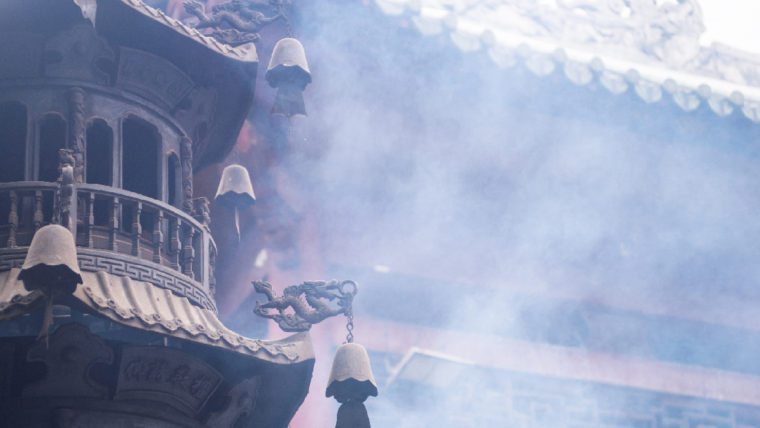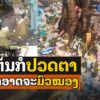Introduction
Buddhism has been in China since ancient times. It is generally believed that it entered China in 67 A.D during the Han dynasty from the Hotan (206 BC to AD 220) in Xinjiang to Central China. It continued influence during Jin (AD 265-420), Sui (AD 581-618) Dynasty, and continues till the present day. Hence, to understand this significant religion, it is important to learn more about the notable monks who both contributed and helped to spread Buddhism in China. Out of this Kumārajīva, known as “the world’s great translator”, he had translated many Buddhist texts particularly Mahāyana texts. Thought, previously Chinese rendition of Buddhist texts had been crude or even incoherent. So, Kumārajīva’s translations, however, enabled to clear understand the Buddha’s teachings. In this paper, I am going to provide Kumāragiva and his contributions to Buddhism in China.
Background
Kumārajīva (343-413) was born in the central Asian city of Kucha. He was a son of Kumarayana and a Kuchean princess named Jivaka, a sister of king Kucha. The Kumārajīva’s name came from a combination of his parents’ name, taking the “kumā” from his father’s name, and “jīva” from his mother. Thus, his name become Kumārajīva. When Kumārajīva seven years old, his mother renounced the world and regular life to join a Buddhist nunnery. Kumarājīva eventually followed his mother became a novice, and quickly revealed a great memory and strong intellect, despite his young age. He was able to recite many texts and several Sutras, Sastras, and also thousand Gāthās.
Education
At the age of nine, his mother brought him to the Kashmir in order to receive an advanced education. He studied the Āgamas and Abhidharma texts under the famous master Bandhudatta. At twelve, he and his mother decided to return to Kuchā, where he studied Dirghā Agama, Madhyamā Agama, and the Kṣudraka with other renowned scholars, including relatives of the king. After studying a further three years, he and his mother returned to Kachā. On the way there, he encountered an Arhat who predicted that he would become a great scholar and introduce Buddhism to many people in the future.
For over a year, Kumārajīva stayed in Kashgar, where he concentrated on studying the Jñānaprasthāna Śāstra, a Sarvāstivādin Abhidharma treatise with the Kashmian scholar who lived in Kashgar. Besides that, he showed an interest in the study of other Indian philosophies, such as four Vedas and the five sciences (grammar, logic, metaphysics, medicine, and the arts and crafts). As a result, he became very knowledgeable in the field of Buddhism and Indian literature.
While in Kashgar, Kumārajīva met a Mahāyānist monk called Sūtyasoma, who was a prince of the Yarkand (in the region of the Tarim Basin). Both Sūtyasoma and his older brother, Sutyabadda had become monks at an early age, around the same time Kumārajīva was introduced to the Mahāyana Buddhist tradition. Sūtyasoma had been taught the Anavatapta-nāgarāja-paripṛcchā-sutra—a detailed explanation of the five aggregates, known as the “pancca khandas” (Dhātus, and Āyatanas are all empty and without the mark). He eventually converted to the Mahāyāna tradition, which was an entirely new philosophy for him, and led him to give up adherence to Hīnayana (present-day Theravāda).
After arriving at Kuchā, Kumārajīva taught Mahāsannipāta and Avatamsaka sutras to the king’s daughter, who had become a nun. As a result, at age 20, he received a higher ordination in the royal palace. During this time, his preceptor was Vimalaksa, and he studied the Vinaya Pitaka of the Sarvāstivāda school. At that time, there were more than 10,000 monks living in Kuchā, who was strongly supported by the King. More significantly, he spent the next twenty years concentrating on Mahāyāna sūtras and Śāstras. His biography reports that he studied the three Śāstras of Nāgārjuna and Āryadeva, which were later to become the central texts of the Sanlun school in China, all of which he may have obtained in Kashgar. According to the report of a Chinese monk named Seng Chun who traveled to Kucha, it was in AD 379 that Kumārajīva’s fame had spread throughout China, leading to many emperors wanting him as their advisor.
Imprisonment and Release
While Kumārajīva was well-known in India and central Asia, he was very famous in China. In AD 379, a Chinese Buddhist monk named Seng Jun visited Kucha. After his departure, he told of Kumārajīva’s abilities, resulting in king Fu Jian of the Qin dynasty desiring to bring him to the capital city Chang’an. In order to do this, the king sent his general, Lu Guang, whose army conquered Kuchā, and brought back Kumārajīva with him. Being a non-Buddhist, Lu Guang treated him with all kinds of indignities, including keeping him imprisoned for around 16 years in the western kingdom.
During this time, being forced to serve as an official, Kumārajīva became familiar with the Chinese language and studying until he became very proficient. Yet another indignity against Kumārajīva came in the form of forced marriage. Lü Guang forced him to marry Kucha’s king’s daughter, resulting in the violation of his chastity vow.
Later, Emperor Yao Xing (ruler during the later Qin dynasty) made a request to Lu Guang to release Kumārajīva, which Lu Guang rejected. Finally, Yao Xing (AD 366-416) in anger sent his army to Lian Gzhou, where he defeated Lu Gaung and rescued Kumārajīva. After Yao Xing and his family overthrew Fu Jian, Yao Xing sent Kumārajīva east to Chang’an in AD 401.
Kumārajīva’s Life in Chang’an
After being released from captivity, Kumārajīva’s life greatly improved. He was warmly welcomed by King Yao Xing, and was appointed as a Buddhist teacher. His skill as a teacher earned him the reputation as “the national teacher who came from the Western regions.” Besides working as a Buddhist teacher, he was appointed as an advisor to, including in times of war when the nation was faced with attacks from their opponents. Believing in the importance of showing kindness to all living beings, Kumārajiva did what he could to avoid violence and bloodshed, and sought peace and mercy as much as was possible.
In addition to these heavy responsibilities, Kumārajiva accomplished many great things during his time in Chang’an. For one, he and other Chinese monks collaborated on the task of editing, collecting, and translating Buddhist texts from Sanskrit into Chinese. Furthermore, Kumārajīva at one time addressed an assembly over eight hundred monks at Chang’an. In addition, Yao Xing also had many towers and temples built through the influence of Kumārajīva. Perhaps most notably, it said that over 90% of the population became Buddhist followers through his able teaching and diligent efforts.
Kumārajīva’s Contributions to Buddhism in China
After Kumārajīva had stayed in the Chang’an he was well-versed in Buddhism, due to his very broad and deep study of Buddha’s teachings. In response to the wishes of the king, he took on the Chinese monk, Seng-Jui, as his disciple, and began another major work of translation.
From AD 402 to 413, Kumārajīva and his staff translated 74 works in 384 fascicles, of which only 39 works in 313 fascicles are still extant. However, it must be noted that other sources claim that there are 55 and 52 extant works respectively that can be attributed to Kūmarājiva. Those works can be divided as follows:
- The first group is the most important volume, due to its variety and richnesses. It is known as his Prajñāpāramitā (“perfection of wisdom”) texts:
• The Pañcaviṃśatisāhasrikā Prajñāpāramitā-sūtra, which was completed in AD 404. According to the class notes, this text is similar to the Fangguang Jing and the Guangzhan Jing.
• The Prajñāpāramitāsūtra, written in in 408, is a version of the Aṣṭasāhasrikā, similar to the Daoxing Jing and the Damingduwuji Jing.
• The Vajracchedikā Sūtra (“Diamond Sūtra”). which consists of 32 sections.
• The Prajñāpāramitāhṛdaya sutra (“Heart Sūtra”). It is said to present the heart, or the essence, of the Prajnaparamita teachings, which are the definitive teachings on the Mahayana view of the interdependent nature of reality.
• The Śūraṃgamasamādhi-sūtra (“Sūtra on the Heroic-March Concentration”) an early Mahāyāna sūtra that explains how the mind becomes free and unimpeded. - The second group consist of individual translations, which became the bases for distinctive exegetical traditions, or group of texts, especially the Tattvasiddhi Sātra (“contemplation of truth”) and Sanlun (“Three Treatises”) of the Madhyamaka school. It must be noted that Kumārajīva introduced these teachings to Nāgārjuna, who later taught it to his disciple, Aryadeva.
Pure Land Buddhism texts:
· The Amitābha Sūtra or the Smaller Sukhāvativyūha, which is about the “Pure land paradise” in the west (written in AD 404).
· The Daśabhūmivibhāṣā Śāstra, which is actually attributed to Nāgārjuna, who collaborated with his friend from Kashgar, Buddhayaśas. All of these texts became central to the Chinese Buddhist community.
Other texts:
• Maitreya-vyākaraṇa-sūtra
• Saddharmapuṇḍarīka-sūtra (“perfection of wisdom”), written in 25,000 lines. Written in AD 404.
• Vimalakīrtinirdeśa-sūtra
• Satyasiddhi-śāstra by Harivarman
• Sarvāstivāda Prātimokṣa Sūtra.
• Lotus sutras
Madhyamaka:
• Madhyamaka-śāstra, a treatise consisting of verses by Nāgārjuna and commentary by Piṅgala.
• Dvādaśanikāya-śāstra by Nāgārjuna
• Śata-śāstra by Nāgārjuna’s disciple Aryadeva
• Mahāprajñāpāramitā-upadeśa by Nāgārjuna - Kumārajīva’s translation also included various types of songs and poetry, legends and stories, literary styles and motifs, and a vast repertoire of religious images.
- Fourth, Kumārajīva taught a group of gifted students who wrote texts that formed the foundation of East Asian Buddhism, including Seng-zhao (AD 374–414), Dao-sheng (ca. AD 355–434), Sengrui (AD 352–436), among several others.
- Fifth, there were the other works that became famous after his retranslation. As mentioned previously, although the Saddharmapuṇḍarīka Sūtra, smaller sukhāvativyūha and Vimalakīrtinrdesa Sūtra had been translated by Dharmaraksa, Kumarārajīva’s translations were clearer and thus easier to read and understand. This resulted in his translations becoming widely circulated and influential in Chinese Buddhist circles. This was helped by the fact that, under Kumārajīva’s influence, many had become intelligent and learned in Chinese traditional culture.
Later, the Saddharmapuṇḍarīka Sūtra became the basic text of the Tiantai school and Nichiren sect in Japan. The Smaller Sukhāvativyūha became one of the three major texts of the Pure Land Tradition, while the Vajracchedikā continues to be esteemed as a basic text of the Chan school. Furthermore, the Da Chidu Lun was very influential in the Zhenyan or Shingon (i.e. Vajrayāna) school in China and Japan, while the Vimalakirtinirdesa popularized the ideal of the bodhisattva. - Sixth, his translations helped shape the history of medieval Chinese Buddhism. The Satyasiddhi Śāstra (Chengshi lun, or “Completion of Truth”), which had many commentaries written on it, became the most widely studied and influential work in the South during the Southern Qi (AD 479–502) and Ling (AD 502–557) dynasties, and the Sarvāstivāda Vinaya became one of the two Vinaya systems prevalent in China and Japan. The old line transmission of the Sanlun school persisted until the time of Jizang (AD 549–623) of the Sui dynasty (AD 581–618).
Kumārajīva’s style translation
As stated already, accoding to the historical background of Buddhism in China, the Buddhist texts had been translated before Kumārajīva came to Chang’an, but those texts contained difficult words that made it difficult for Chinese readers to comprehend. However, through his retranslations, people could better understand them. He succeeded in doing this by borrowing terms from traditional Chinese writings, such as those of Confucius and of Taoism. For example, he used Toaist terms (that had similar meanings to the concepts used in Buddha’s writings) that the people were familiar with in order to explain Buddhist terms that the people were not familiar with, a method of explanation known as “geyi” (concept-matching). His translation style was possessed a distinctive flow and smoothness that reflected the importance of conveying the meaning as opposed to precise literal rendering.
Sheng-jui who realized the limitation inherent in the geyi method stated that “After attending the sessions in which Kumarajiva produced his translations, I was for the first time able to comprehend the concept of Shunyata, or emptiness, that lies at the core of the Prajnaparamita.” Thus, by comparing it to the similar Daoist concept of Wu (non-being), Kumārajīva was able to help people like Dao’an to gain a deeper understanding of Buddhist thought.
In light of these amazing accomplishments, notable Japanese scholars descrbied Kumārajīva in the following way:
“Kumārajīva was a man of outstanding linguistic talent who possessed a command of Sanskrit, the languages of Central Asia, and Chinese. Second, he had a broad understanding of all phases of Buddhist doctrine, having mastered not only the Hinayana Sarvastivada writings but the Mahayana works dealing with the concept of prajna and the Madhyamika teachings, and he was conversant with the vinaya, or rules of monastic discipline, as well. Third, is the fact that Yao Hsing and the leaders of the Chinese Buddhist words of the time took steps to create conditions that would be ideal for the production of Kumarajiva’s translations. Fourth and finally, Kumarajiva had many talented young disciples and assistants to aid him in his labours.”
In the same manner, descriptions left by his disciples reveal his genius and efficiency. Kumārajīva and his team would take the sutras coming from foreign lands in hand and would translate them orally into Chinese while ensuring that they never violated the meaning of the original. This was ensured by the fact that the other monks would hold the text of the older translations of the sutras in their hands, and use them to check the translations for errors, constantly inquiring about the general purpose of the passage, thus ensuring that the doctrines of the sect were preserved.
For example, we have the translation of “lotus sutra”, which was initially translated in AD 286 by Chufahu. While an expert in linguistics, most notably in all the languages used in central Asia, he struggled to translate the Lotus sūtra into Chinese, requiring the assistance of other translators. He apparently did not have a sufficient understanding of Chinese syntax to translate the text himself. Kumārajīva, however, had sufficient learning and understanding to avoid making the kind of errors that earlier translations had and could point out and correct such errors when they came to his translation.
However, it must be noted that he, too, still needed help from other scholar monks to check and reread the errors. For the instance, when there was some point about Buddhism that he did not fully comprehend, he did not hesitate to ask for assistance from others who were more versed in the topic under consideration. An example of this was the monk named Buddhayashas, who was very learned in the field texts, having a profound understanding of these sacred texts. Kumārajiva would, in times when he struggled to understand certain texts, approach Buddhayashas. Thus, Kumārajīva never tried to hide the fact that he did not understand something, in order to propagate the Buddhist teachings correctly. As a result, he was able to produce a lot of valuable translations that can be used till present day.
Conclusion
In summary, Kumārajīva was a notable Buddhist monk who became a novice in Kuchā, Central Asai. Throughout his studies with various teachers from different Buddhist traditions, he became a knowledgeable and well-known monk. Eventually, he had a capacity to translated many Buddhist texts sun as Mahāyana texts.
In addition, Kumārajīva revolutionized Chinese Buddhism giving clarity to the previously translated texts by using the “geyi” (concept-matching) system of translation. His translation style was distinctive, possessing a smooth flow that reflects his prioritization on conveying the meaning as opposed to precise literal rendering. Because of this, his renderings of seminal Mahayana texts have often remained more popular than later translations, such as Xuanzang. Sengrui had some influence on this final polished style.
References
Buswell, Robert E, and Donald S. Lopez. The Princeton dictionary of Buddhism. Princeton, NJ: Princeton University Press, 2013. Print.
Buswell, Robert E.Encyclopedia of Buddhism.New York: Macmillan Reference,USA, 2004.Print.Volum 2.
Ikeda, Daisaku, and Burton Watson. The flower of Chinese Buddhism. Santa Monica, Calif: Middleway Press, 2009. Print.
Jones, Lindsay, Mircea Eliade, and Charles J. Adams. Encyclopedia of religion. Detroit: Macmillan Reference USA, 2005. Print volume 8.
Kumārajīva, Tsugunari Kubo, and Akira Yuyama. The Lotus Sutra. Berkeley, Calif: Numata Center for Buddhist Translation and Research, 2007. Print.
Puri, Baij N. Buddhism in Central Asia. Delhi: Motilal Banarsidass, 1987. Print.
Watson, Burton, and Kumārajīva. The Lotus Sutra. New York: Columbia University Press, 1993. Print.
Zürcher, E. The Buddhist conquest of China: the spread and adaptation of Buddhism in early medieval China. Leiden: Brill, 2007. Print.
Internet sources
Web access November 8, 2020
https://en.wikipedia.org/wiki/Chinese_Buddhism#The_arrival_of_Kum%C4%81raj%C4%ABva_(334%E2%80%93413_CE)
Kumarajiva. Web access November 10, 2020
https://www.encyclopedia.com/people/philosophy-and-religion/buddhism-biographies/kumarajiva
Kumarajiva Great Man and Culture Event. Refried from: Web access November 8, 2020
https://www.academia.edu/42253743/Kumarajiva_Great_Man_and_Cultural_Event?auto=download




